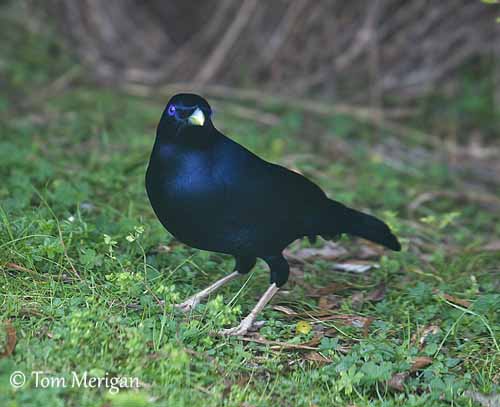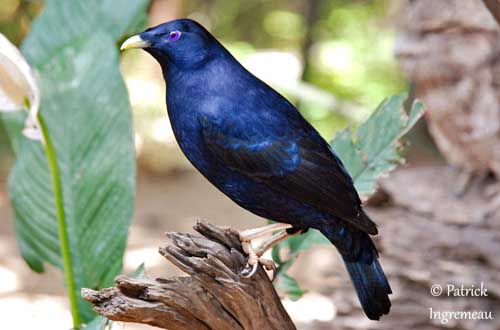
Fr: Jardiner satiné
All : Seidenlaubenvogel
Esp : Pergolero Satinado
Ital : Uccello di raso
Nd: Satijnblauwe Prieelvogel
Sd: Glanslövsalsfågel
Photographers:
Jean Michel Fenerole
Photos d’Oiseaux du monde
Patrick Ingremeau
TAMANDUA
Tom Merigan
Tom Merigan’s Photo Galleries
Text and illustration by Nicole Bouglouan
Sources:
HANDBOOK OF THE BIRDS OF THE WORLD Vol 14 by Josep del Hoyo-Andrew Elliot-David Christie - Lynx Edicions – ISBN: 9788496553507
Ottaviani, M. (2014). Les Oiseaux à berceaux - Histoire naturelle et photographies, 262 pages. Editions Prin, France. ISBN 978-2-909136-41-7
L’ENCYCLOPEDIE MONDIALE DES OISEAUX - Dr Christopher M. Perrins - BORDAS - ISBN: 2040185607
BirdLife International (BirdLife International)
Birds in backyards (Birds Australia and Australian Museum)
Portfolio. Dr Ellen K. Rudolph - A Conservation Collection
Wikipedia, the free encyclopaedia
Satin Bowerbird
Ptilonorhynchus violaceus
Passeriforme Order – Ptilonorhynchidae Family
BIOMETRICS:
Length: 32-33 cm
Weight: M: 173-290 g – F: 170-258 g
DESCRIPTION:
The Satin Bowerbird is probably the best known species of this family. The male’s displays around the bower are an amazing spectacle.
The adult male has glossy indigo-blue plumage overall. According to the light, we can see violet to black iridescence. On the wings, primary flight feathers are blackish. Tertials and upperwing-coverts show glossy tips contrasting against the blackish bases. On the blackish tail, each rectrice shows strong indigo-blue gloss at tips and outer edges.
On the underparts, lower belly and thighs are duller and slightly more blackish than rest of plumage. Undertail-coverts are blackish too, with glossy edges.
The bill is whitish to pale greenish-yellow, with some blue wash at base. The eyes are bright purple with deep blue outer edge. Legs and feet are pale-coloured, usually pale pink.

The female has ashy grey-green upperparts with cinnamon-brown wings and tail.
The underparts are green with whitish streaks on chin, throat and upper breast. Rest of underparts is scalloped and barred greenish.
The bill is blackish. The eyes are deep blue. Legs and feet are pale flesh to grey.
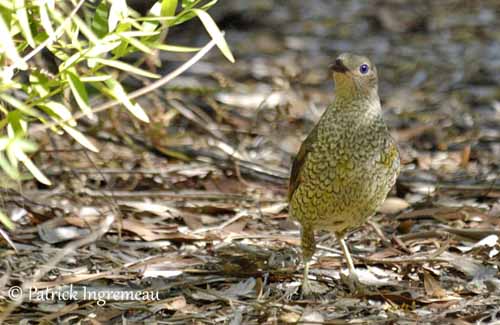
The juvenile has duller plumage, rather greenish and brown.
The immature resembles female for first three years. It acquires the full adult plumage step by step between fourth and seventh years.
We can find two subspecies:
P.v. violaceus (here described and displayed) is found in SE Queensland, S in coastal areas to S Victoria.
P.v. minor is found in the wet tropics of the NE Queensland in E Australia. This race is smaller than nominate, and female shows dull bluish-grey wash on the upperparts.
VOICE: SOUNDS BY XENO-CANTO
The Satin Bowerbird has wide repertoire of sounds such as whistles, buzzing and hissing. It may perform mimicry of both avian and human-made sounds.
The advertising song of the male is a clearly whistled “quoo-eeeew”, and we can also ear a loud “weeoo”.
The female at nest sometimes mimics the calls of potential predators.
Outside the breeding season, flocks are vocally noisy.
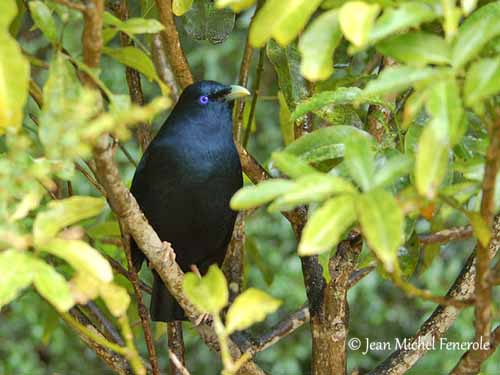
HABITAT:
The Satin Bowerbird frequents humid forests and woodlands and their edges. It is also found in nearby open areas. During winter, flocks frequent open habitats such as parks, gardens and orchards.
The bower sites are usually dispersed through suitable rainforest and woodlands.
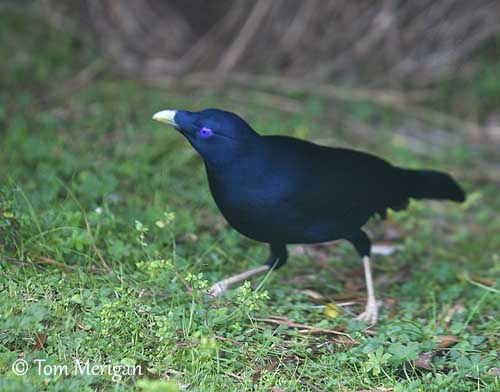
RANGE:
See above in “subspecies”
BEHAVIOUR:
The Satin Bowerbird feeds mainly on plant matter such as fruits, flowers, leaves, seeds and nectar. During the breeding season, numerous insects are added to this vegetal diet.
This species forages and feeds at all levels, and fruits are often taken in canopy, 18-20 metres or more above the ground. Insects are caught by gleaning and sallying.
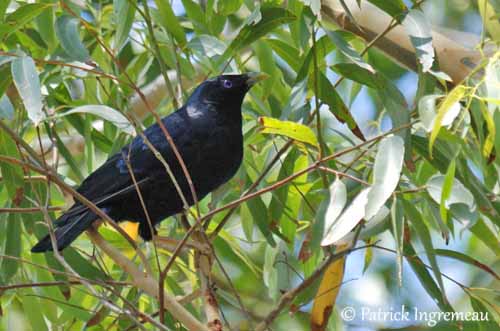
The Satin Bowerbird may forage alone or in family groups, and even with other fruit-eater birds. At food sources, the younger birds are dominated by adult males.
During the breeding season, the male feeds mainly on insects in close vicinity of its bower. During winter, they feed in large flocks of up to 200 birds, taking mainly plant matter.
The displays of the male are well known. Displays take place close and around the bower which includes a layer of twigs placed on the ground. Then, it builds two parallel arched walls on each side of the layer, made with twigs arranged vertically. This structure is similar to an avenue of about 45 centimetres long.
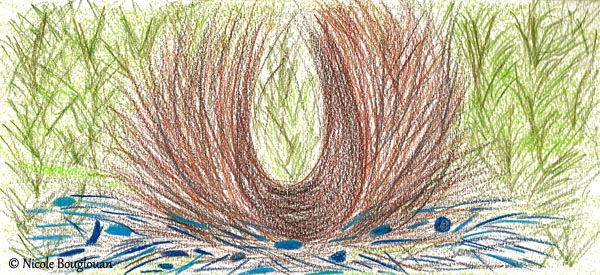
Then, the bower is decorated with bright blue objects found in the habitat. We can see flowers or berries, but also snail shells and snake skin, feathers, and even man-made items such as pen caps, bottle capsules and many others objects.
It may “paint” the inner walls with ground charcoal, fruits mixed with saliva or crumbly tree bark.
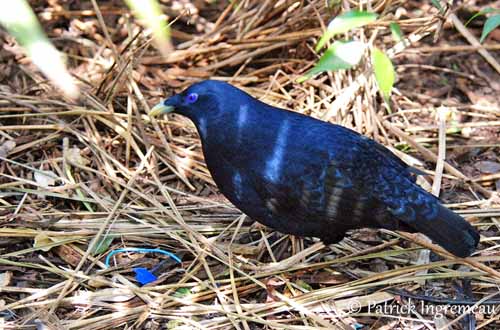
The bower attracts the females which visit the structure while the male performs dramatic displays. It runs around while producing a loud buzzing. Wings are repeatedly spread and closed. It picks some ornament with the bill while displaying, adopting a “trance-like” posture with head low, brighten eyes and jumping sideways. Once a female is attracted, copulation occurs near the bower.
Males must have strong and aggressive displays for mating success, and to get numerous partners.
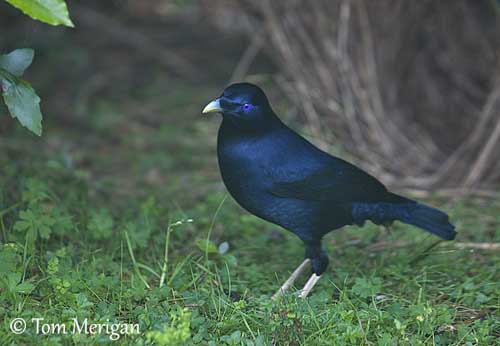
Then, the female flies off and builds a nest where she will lay her eggs. The male does not take part in nesting duties. The female will care and rear the young alone while the male will display to attract other females.
The Satin Bowerbird is mainly resident in its range. The birds of woodlands may move into more open habitats and form flocks during winter. Some local seasonal movements to lower altitudes are observed too.
FLIGHT:
The Satin Bowerbird flies rapidly from tree to tree. When flying in flocks, they fly clearly above treetops with the typical flap-glide undulating flight.
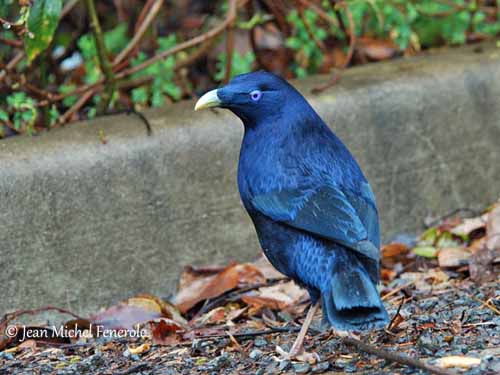
REPRODUCTION:
Breeding season occurs between late August-September and January.
After mating, the female builds a separate nest, a shallow cup made with sticks and twigs. The inner cup is lined with green and dry leaves. The nest is placed in tree or bush, between 2 and 40 metres above the ground, usually about 15 metres.
The same nest-site is often reused by the same female.
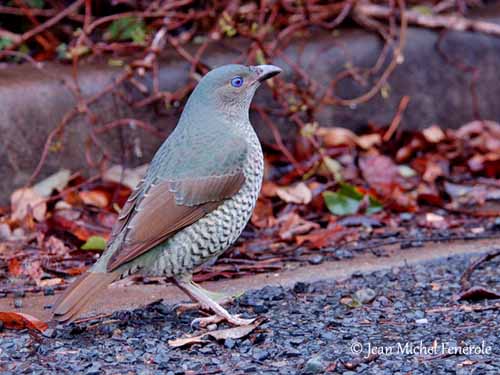
She lays 1-3 pale brownish eggs with darker markings. She incubates during about three weeks. The young leave the nest 17-21 days after hatching. The female often performs anti-predator behaviour, chasing away intruders and performing the “broken wing” distraction display.
The young still depend on their mother for food during some weeks more after leaving the nest. They are sexually mature at seven years old. Both sexes can live up to 20-30 years at least.
DIET:
The Satin Bowerbird feeds primarily on fruits, flowers, leaves, seeds, nectar, and takes insects during the breeding season. They feed by gleaning and sallying for invertebrates.
PROTECTION / THREATS / STATUTS:
The Satin Bowerbird is relatively common in remained habitat, but it is vulnerable to habitat loss with deforestation and fragmentation of forests. However, this species is not currently threatened.
